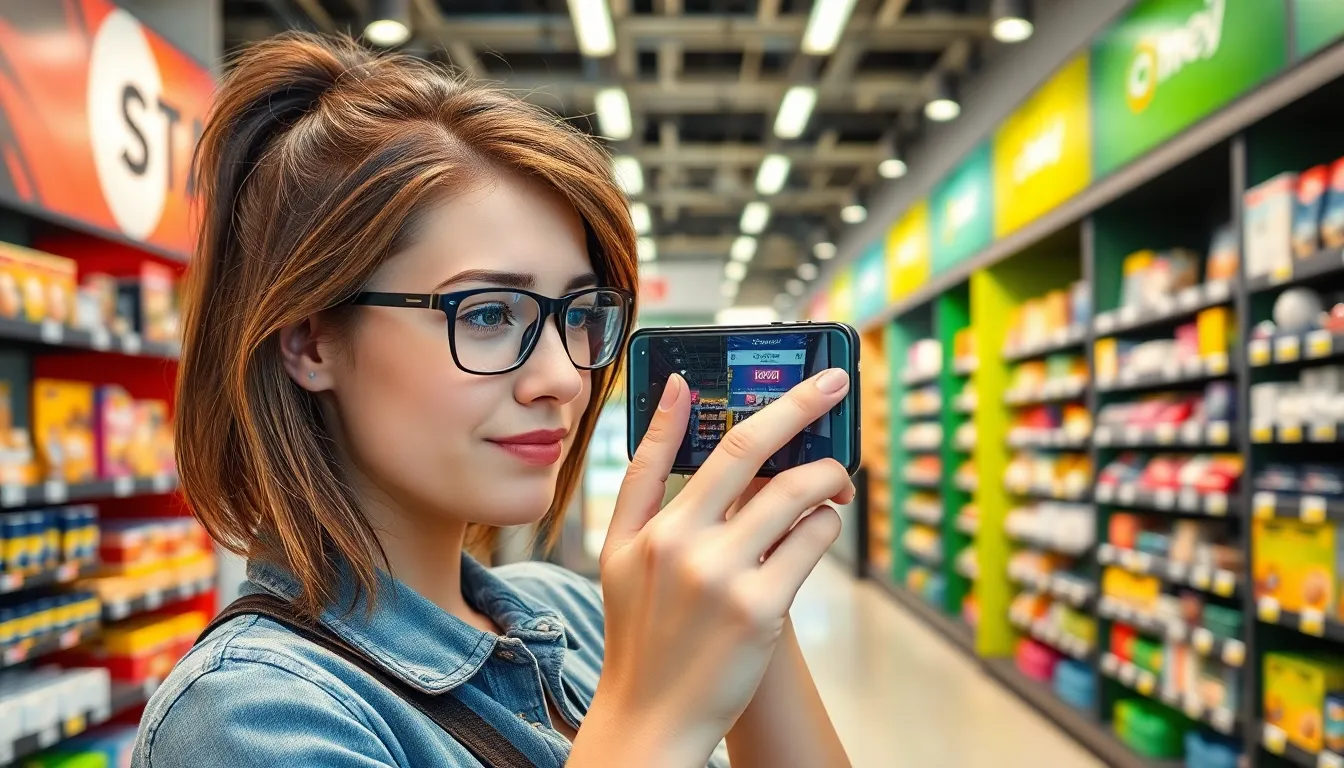Table of Contents
ToggleImagine walking into a store where the clothes practically jump off the racks and beg to be tried on. With augmented reality in retail, this isn’t just a wild dream; it’s becoming a reality. Retailers are harnessing this cutting-edge technology to transform the shopping experience, making it more interactive and engaging than ever.
Overview of Augmented Reality in Retail
Augmented reality (AR) transforms how retail interacts with customers. This technology overlays digital information onto the physical shopping environment, creating immersive experiences. Customers can visualize products and access additional details through their smartphones or AR devices.
Retailers utilize AR to offer virtual try-ons, 3D product views, and interactive displays. Virtual try-ons allow customers to see how clothing items fit without physically trying them on. For instance, some brands like Warby Parker enable users to virtually wear glasses through their apps.
Interactive displays enhance product details, enabling shoppers to scan items for reviews, specifications, and usage tips. IKEA’s app offers a feature where customers place virtual furniture in their home spaces to see how it fits.
Cost-effectiveness is another benefit. AR reduces the need for extensive physical inventory. It minimizes the risk of product returns by allowing customers to make informed decisions before purchasing.
Data shows AR can boost customer engagement significantly. According to a study by Deloitte, nearly 40% of consumers are willing to use AR for shopping. Retailers leveraging AR technology have reported increased customer satisfaction and loyalty.
AR applications in retail extend beyond just fashion and home goods. Beauty brands like Sephora provide virtual makeup trials, offering a personalized shopping experience. Companies in various sectors are integrating AR to enhance consumer interaction and streamline their sales processes.
Retailers embracing augmented reality set themselves apart in a competitive market. This technology not only enhances shopping engagement but also fosters richer customer relationships. As AR continues to evolve, its impact on the retail landscape will likely expand, making the shopping experience more interactive.
Benefits of Augmented Reality in Retail

Augmented reality (AR) significantly benefits the retail industry by revolutionizing traditional shopping methods.
Enhancing Customer Experience
AR improves customer experiences by allowing shoppers to visualize products in real-time. Virtual try-ons let customers see how clothing fits without stepping into a fitting room. For instance, Warby Parker enables users to virtually try on glasses, eliminating uncertainty in purchasing. Customers also appreciate interactive displays that offer additional information about products, enhancing decision-making. Personalized shopping experiences foster deeper connections with brands. Brands using AR often see improved customer satisfaction and increased loyalty, as shoppers prefer engaging and immersive experiences over conventional ones.
Increasing Engagement
AR leads to higher customer engagement by capturing attention in unique ways. Nearly 40% of consumers, according to data, express a willingness to use AR while shopping. Features like 3D product views provide an enhanced understanding of items before purchases. Retailers like IKEA allow shoppers to visualize furniture in their homes, making the buying process more enjoyable. AR transforms passive browsing into interactive experiences, prompting customers to spend more time exploring products. This integration fosters a more dynamic connection between brands and customers, solidifying AR’s role in driving retail innovation.
Examples of Augmented Reality Applications
Augmented reality (AR) applications in retail showcase how this technology enhances shopping experiences. Various brands employ AR to create interactive encounters that engage customers.
Virtual Try-Ons
Virtual try-ons allow customers to see how clothing or accessories will look before making a purchase. Retailers like Warby Parker offer features enabling users to fit glasses virtually. Customers can upload images or use camera functionality to visualize products on themselves. This not only reduces the uncertainty associated with online shopping but also minimizes return rates significantly, providing a more satisfying buying experience. Having nearly 40% of consumers open to using virtual try-ons demonstrates AR’s potential in transforming fashion retail.
In-Store Navigation
In-store navigation powered by AR guides customers through retail spaces, enhancing their shopping journey. Apps utilize AR to provide real-time directions, helping shoppers locate specific products quickly. This application improves efficiency, particularly in large stores or complex layouts. Retailers can also integrate promotional information, boosting customer engagement during the shopping process. Implementing AR navigation can increase foot traffic in key areas, enriching the overall customer experience while facilitating interactions with products.
Challenges of Implementing Augmented Reality in Retail
Augmented reality (AR) in retail brings unique challenges that companies must navigate. These obstacles include technical limitations and cost considerations.
Technical Limitations
AR requires significant technological infrastructure to function effectively. Many retailers face challenges with device compatibility since not all customers possess AR-enabled smartphones or tablets. Furthermore, limited internet connectivity affects the delivery of AR experiences. Software development also presents hurdles; creating interactive AR content demands skilled developers and robust platforms. Lastly, usability concerns arise as some customers may struggle with the navigation of AR applications, which could hinder the intended immersive experience.
Cost Considerations
Adopting AR technology entails considerable investment. Initial setup costs for hardware and software can quickly accumulate, which may deter smaller retailers. Additionally, ongoing maintenance and updates for AR systems contribute to long-term financial commitments. Training staff is another factor; employees require training to support customers in using AR features effectively. Ultimately, while AR promises enhanced customer engagement, companies must carefully assess the financial implications against anticipated returns.
Future Trends in Augmented Reality for Retail
Augmented reality in retail is set to evolve significantly in the coming years, driven by technological advancements and changing consumer expectations. Retailers are likely to adopt more sophisticated AR solutions that blend seamlessly with existing systems. Companies may enhance customer experience with AI-powered AR applications that provide personalized recommendations based on user preferences.
Increased integration of AR with mobile platforms is anticipated. This shift enables customers to engage with brands anytime and anywhere, leading to more spontaneous buying decisions. Immersive experiences will expand beyond try-ons, incorporating virtual showrooms and customizable environments where users can visualize products in their own settings.
Improved hardware capabilities play a crucial role in this trend. With the rise of 5G connectivity, AR applications will run smoother and offer higher quality graphics. Such advancements allow consumers to explore detailed product information without lags, increasing overall satisfaction.
Real-time data integration stands to change shopping experiences. Retailers can collect and analyze user interactions, adapting offerings to meet customer needs. This data-driven approach will enhance customer loyalty, as brands tailor marketing efforts based on engagement insights.
Notably, partnerships between AR companies and major retailers may increase. Collaborations will enable the development of cutting-edge AR features that improve brand visibility and consumer reach. These strategic alliances drive innovation, as brands leverage technological advancements to create unique in-store experiences.
Lastly, sustainability will become a focal point. Retailers may use AR to showcase eco-friendly initiatives, helping consumers make informed choices and aligning brands with environmentally conscious values. As the landscape of retail continues to change, augmented reality will lead the way in creating engaging, efficient shopping experiences.
Augmented reality is transforming the retail landscape by creating interactive experiences that resonate with consumers. As technology continues to advance AR’s applications are expected to expand further enhancing customer engagement and satisfaction. Retailers embracing AR not only differentiate themselves but also foster deeper connections with their audience.
The future of retail will likely see more seamless integration of AR with existing systems and enhanced mobile capabilities. This evolution promises to redefine shopping experiences making them more personalized and efficient. As brands leverage AR to align with consumer expectations and values sustainability will also play a crucial role in shaping the industry’s direction. Ultimately AR is set to revolutionize how customers interact with retail environments paving the way for a more immersive shopping journey.







